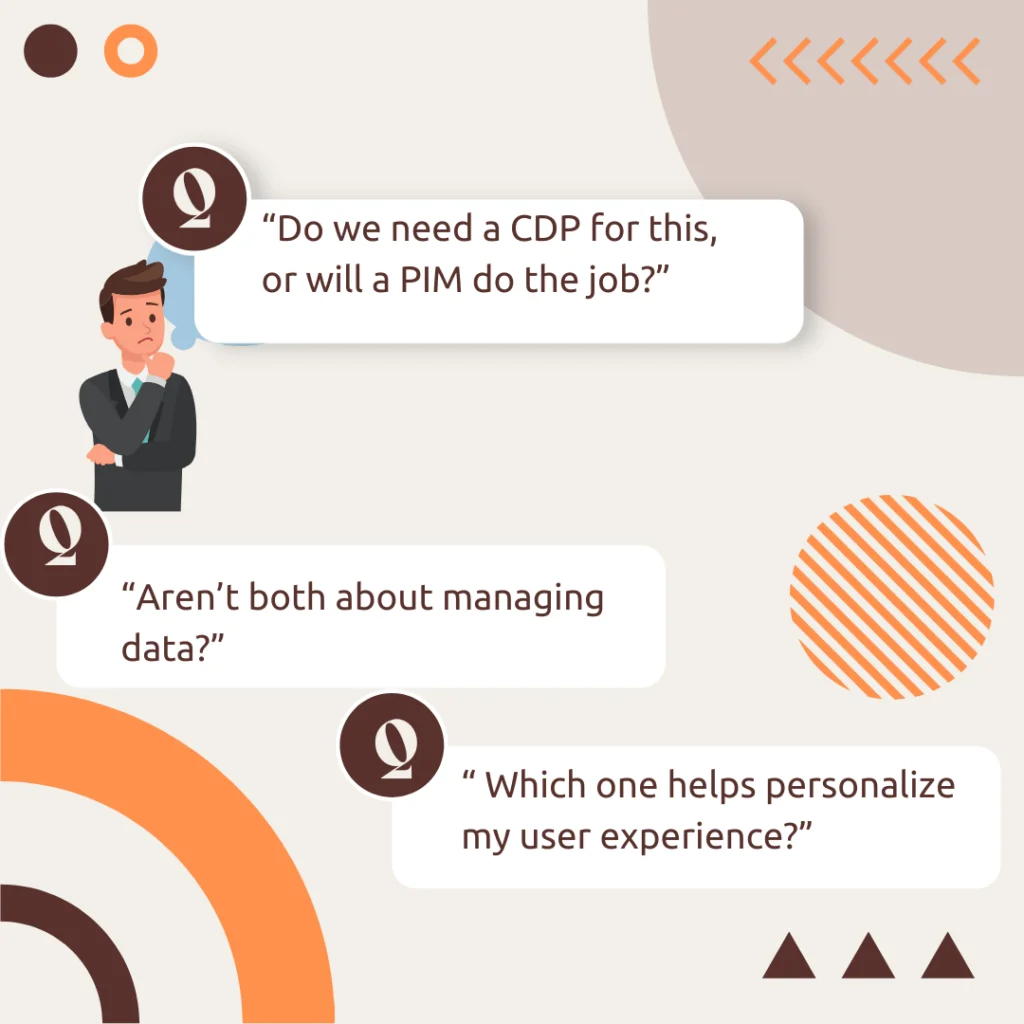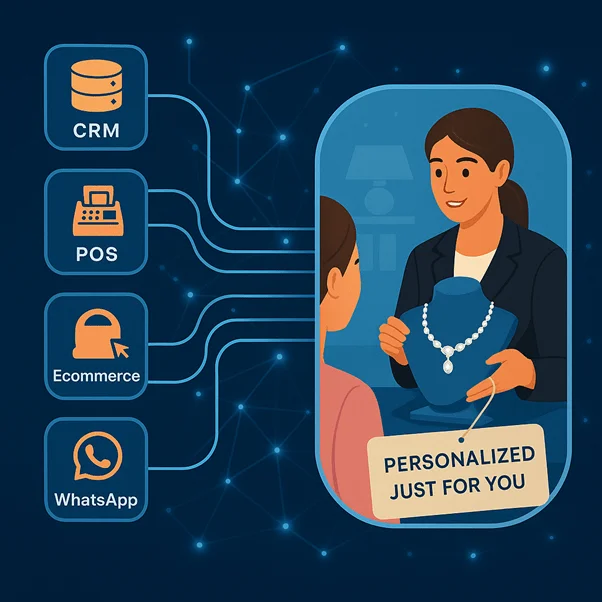Customer and product intelligence have become the twin engines of modern business growth.
But as more brands strive to become data-driven, we’ve seen a growing confusion emerge—between two tools that sound similar but serve radically different goals: the Customer Data Platform (CDP) and the Product Information Management (PIM) system.
Whether you’re a retail giant launching flash sales, an automotive OEM selling directly to consumers, or a jewellery brand offering personalised gifting experiences, the playbook is the same:
Know your customer, and present the right product—instantly, and everywhere.
From product detail pages that need to speak 10 languages, to marketing campaigns that must address 1,000 segments—data is no longer a back-end asset. It’s the front line of engagement.
As a result, more businesses are diving into data platforms that promise customer and product intelligence… But here’s where things often get tricky:

We’ve seen CMOs in fashion, CXOs in BFSI, and even product heads in automotive ask these exact questions, in our digital consulting workshops. And that is why we set out to write this blog.
Customer or Product Intelligence—Which Side Are You On?
It’s understandable—Customer Data Platform (CDPs) and Product Information Management (PIM) systems both deal with data, but they serve very different purposes.
When businesses try to jump into data-driven decisions without clarity on CDP vs. PIM, they risk not just wasting money, but missing the moment.

In a market where the CDP space is projected to grow from $2.65 B in 2024 to $12.96 B by 2032 (a blistering 21.7% CAGR, as per Fortune Business Insights), and PIM is quietly becoming the backbone of product-‑first firms, understanding these tools is no longer optional—it’s essential.
Pimcore: The Versatile Platform That Gives you the best of CDP and PIM
With its modular architecture and versatility, Pimcore offers both a Customer Data Platform (CDP) and a Product Information Management (PIM) solution—each powerful in its own right, and even more impactful when used together.
What is Pimcore CDP?
Pimcore CDP unifies customer data from multiple touchpoints—web, CRM, offline channels, apps, campaigns—to create a 360° customer profile. The platform allows marketing and CX teams to:
- Segment audiences in real time
- Drive personalized campaigns
- Build behaviour-based automation workflows
- Comply with data privacy laws via centralised data governance
For instance, if you are an automotive OEM, you can use a customer data platform to track a customer’s vehicle servicing journey, configure a hyper-personalized trade-in offer, and push it via the preferred digital channel.
What is Pimcore PIM?
Pimcore PIM focuses on product data—centralizing SKUs, specifications, images, pricing, translations, digital assets, and regulatory content into a single source of truth.
It helps product, marketing, and eCommerce teams to:
- Deliver consistent product content across marketplaces, websites, and dealer apps
- Streamlines catalogue management and updates
- Enrich product data using workflows and DAM integrations
For example: A grocery retailer managing thousands of SKUs across regions can use Pimcore PIM to maintain up-to-date product info, nutritional labels, and pricing across both online and physical stores.
CDP vs PIM: Understanding the Key Differences(and Why It Matters)?
If data is the fuel, then CDP and PIM are the twin engines that convert it into motion—each with a different job, but one common goal: delivering smarter, faster, and more personal experiences.
| Criteria | CDP | PIM |
| Data Type | Customer | Product (what, where, how) |
| Core Focus | Behaviour, identity, intent | Specs, pricing, taxonomy |
| Business Goal | Personalized engagement | Catalog accuracy & speed |
| Used by | Marketers, CX, CRM, data management teams | Product, IT, eCommerce, content teams |
| Output | Targeted campaigns, U/X journeys
Better engagement & loyalty |
Consistent SKUs & localized assets
Faster Go-To-Market, consistent brand experience |
| Real-time capability | Can initiate tailored and instant campaign triggers | Limited, but can help with real-time product updates |
Know Your Customer but Know Your Data First: When to Use a CDP vs PIM:
For CXOs, Heads of Digital, or eCommerce leaders, confusing the two could mean sending a beautifully crafted message… about the wrong product, to the wrong customer, at the wrong time. And in digital, there are no do-overs.
The key is to align tools with purpose and data with intent.
So, we are sharing some quick tips and use cases where you must use one of CDP or PIM.
- Choose Pimcore CDP if:
- You want to personalise digital journeys based on real-time customer behaviour.
- You’re aiming to build loyalty programs, customer segments, or trigger-based campaigns.
- Your CX teams need unified visibility into customer touchpoints across channels.
- On the contrary, go for PIM if:
- You manage thousands of SKUs across platforms and geographies.
- You want to improve product discovery, reduce time-to-market, and ensure catalog accuracy.
- Your sales and marketing teams need consistent product data and visuals, at scale
How Do CDP and PIM Drive Industry-Specific Wins?
Now that we have decoded how Pimcore CDP differs from PIM system, and various scenarios in which they can be used, let’s break down how they work across industries.
- Automotive
- A CDP helps track service milestones, nudges customers with timely reminders (“It’s time for your 30,000 km checkup!”), and fuels loyalty programs.
- A PIM ensures every dealership website showcases the right trims, tech specs, and availability for their region—no more “This variant is unavailable” moments.
- Jewellery & Fashion
- CDP identifies gifting behaviors—like who buys during Dhanteras or Ramzan vs. who shops for Valentine’s—and tailors campaigns accordingly.
- PIM maintains high-res visuals, gemstone certifications, and dynamic pricing for multiple marketplaces in different geographies.
- Retail & FMCG
- CDP an segment users by dietary preferences, shopping frequency, or festive triggers to push relevant bundles.
- PIM syncs real-time inventory, prices, and compliance data (like FSSAI or allergen info) across mobile apps, web stores, and dark stores.
- BFSI
- CDP helps banks craft contextual offers based on financial behaviour (“Just paid off a loan? Here’s a credit card tailored for you”).
- PIM ensures service descriptions, documentation, and digital application forms are up-to-date across all customer-facing portals.

Embitel: Trusted Expert in Pimcore CDP + PIM Implementations
As a certified Pimcore Partner, we don’t just deploy Pimcore—we make it business-ready for your digital transformation goals.
Our team specialises in tailoring both Pimcore CDP and PIM for enterprise needs.
Here are few instances where we have helped global brands to leverage Pimcore for their business success:
- CDP + Product Configurator for an Automotive OEM
- PIM Integration for an Invite-Only App for a Global Enterprise
- Streamlining data management with Pimcore for this Global Home Décor Brand
Checkout how we unified customer and product data streams for the customer, powering smarter journeys, 360-Customer view, and product configurators for their new vehicle segment.
We built customised PIM workflow using Pimcore for a multi-brand F&B group based in the Middle East, that enabled collaborative enrichment across marketing and product teams. This ensured smooth, channel-specific updates while minimising the risk of publishing incomplete or inaccurate data.
We helped this global furniture retailer centralize their product and asset data using Pimcore’s PIM and DAM capabilities. The PIM-based solution not only helped them.
Why Choose One When You Can Have Both?
Pimcore CDP and PIM are not competitors. They’re meant for better collaborations.
By bringing together customer intelligence and product accuracy, you enable your business to:
- Create personalised commerce experiences
- Improve data governance
- Reduce operational silos
- Centralise and clean product data
Ready to explore the right Pimcore integration strategy for your business? Talk to our certified ecommerce consultants at Embitel.
Whether it’s CDP, PIM, DAM—or all three—we’re here to build a solution tailored for your digital future. Drop a mail and schedule a quick demo


